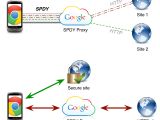Google has just pushed a new Chrome beta for Android, the first update now that the rapid release cycle has been adopted. It comes with the usual improvements, it's slightly faster, has a couple of new additions and so on.
But the big new feature is a "data compression proxy," essentially Opera Turbo for Chrome. Google has leveraged several of its existing technologies to speed up web browsing on Chrome.
Google is rather late to the party, Opera Turbo, Amazon Silk, even the new WebKit Opera for Android, all offer the same features. Google's solution is also rather similar to the ones before it.
In essence, with the feature enabled, Chrome will maintain an SPDY connection to the Google cloud through which regular HTTP traffic will be routed.
Via the proxy, all web resources are optimized and compressed, images are converted to WebP and so on.
The feature is experimental, you'll have to enable it in the chrome://flags section, look for "Experimental Data Compression Proxy" and turn it on.
With it enabled, a permanent SPDY connection to Google is maintained. This means that TCP packets can be multiplexed, more can be sent in parallel, speeding things up while not creating any overhead. You get the benefits of SPDY for any website in the world.
All DNS lookups are done via the Google connection as well, Google has an open DNS service available to all already. Note that any encrypted HTTPS traffic is not routed via the proxy. However, all HTTP traffic to the Google cloud is encrypted.
Another benefit of connecting to the Google cloud rather than directly to the site is that websites hosted halfway around the world may actually load faster through Google, which maintains beefy connections between its data centers around the world.
A connection via the Google proxy bypasses the regular internet, with fewer hops websites will load faster.
This alone should result in a noticeable performance improvement, but Google goes deeper. All of the content is optimized with PageSpeed technology, which has been in the works for a few years now.
Regular resources, HTML, CSS or JS files are minified and compressed, all the code is optimized for size. Everything is then gzip compressed before it's served to the Chrome client.
Finally, all images you encounter on the web are converted to WebP, Google's own image format, which results in smaller images, significantly smaller in some cases.
All of this adds up to significant bandwidth savings which in turn means faster loading pages while using up less of your mobile data connection.
The feature is in experimental form for now and it's likely it will stay that way for a while, possibly beyond Chrome 26. If you're interested in a more detailed overview of how it works, you can check out this Google page.

 14 DAY TRIAL //
14 DAY TRIAL // 
